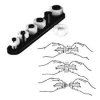Fuel Pressure Tester for DI
Doowacka/anyone,
Do I need to pay to download this manual? I dont suppose anyone would have a picture/instructions of this test rig for fuel pressure testing?
Sorry I didn't get back sooner, but I had to take some pictures of my test rig.
Yes, you need to pay to become a "Premium Member" (at least for awhile) to download manuals from this site. There are a couple of other places online you can download from, but I can't point you to them due to forum rules.
Here are some pics of my fuel pressure test rig I patterned after the one described and shown in the DI manual.
One of the more expensive components would be the pressure gauge, unless you do like I did and just buy then cannibalize a cheap ($10) automotive compression gauge. The high pressure hose is expensive at about $7 per foot, since it is not normal fuel hose but rated at higher pressure (SAE30R9). I elected to have about 4 feet for the long hose piece, so I can feed the gauge up through the hole the "glove box" goes in, then I can watch the pressure while riding to "catch" the failing fuel pump "in-the-act" and verify the problem. I also use a metal 5/16" Quick-Disconnect tool (shown; red tool) which is much nicer than the cheap plastic versions. The female 5/16" Quick-Connect end actually has a built on disconnect, and is fairly easy to find at automotive stores, along with the hose. The most difficult part to find was the male 5/16" Quick-Connect end, which I finally found on the end of a piece of longer steel fuel line, then just cut off a few inches. The other parts are standard brass connections found at any hardware store.
Since the test tool has quick-connects, you can place the tester inline on the supply line to the fuel rail, to observe starting and running pressure. This "system" test would indicate the pressure in the rail due to fuel pump, air compressor, and fuel/air regulators. You can also perform a loop-back test between the quick-connects of the supply and return lines of the fuel module alone. This tests the pump only and uses the valve in the test rig to provide the flow restriction, in order to verify the pump can pump to 107 psi and over. If I had it to do over, I would use a knob (needle) valve which is easier to regulate than the gate (ball) valve I used.














